Flak tower
Flak towers (German: Flaktürme) were eight complexes of large, above-ground, anti-aircraft gun blockhouse towers constructed by Nazi Germany in the cities of Berlin (3), Hamburg (2), and Vienna (3) from 1940 onwards. Other cities that used flak towers included Stuttgart and Frankfurt. Smaller single-purpose flak towers were built at key outlying German strongpoints, such as at Angers in France, Helgoland in Germany.[1]
The towers were operated by the Luftwaffe to defend against Allied strategic air raids against these cities during World War II. They also served as air-raid shelters for tens of thousands of local civilians.
History and uses
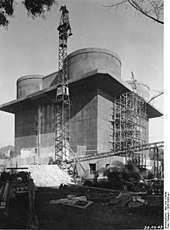
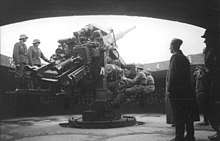
After the RAF's raid on Berlin in 1940, Adolf Hitler ordered the construction of three massive flak towers to defend the capital from air attack. Each tower had a radar installation with a radar dish which could be retracted behind a thick concrete and steel dome for protection.[2]
Hitler was interested in the design of the towers, and even made some sketches. They were constructed in six months. The priority of the project was such that the German national rail schedule was altered to facilitate the shipment of concrete, steel and timber to the construction sites.[3]
With concrete walls up to 3.5 m (11 ft) thick, flak towers were considered by their designers to be invulnerable to attack by the standard ordnance carried by RAF heavy bombers at the time of their construction.
The towers were able to sustain a rate of fire of 8,000 rounds per minute from their multi-level guns (albeit mostly smaller-caliber shells, such as the 2cm FlaK 30), with a range of up to 14 km (8.7 mi) in a 360-degree field of fire. However, only the 128 mm (5.0 in) FlaK 40 guns had effective range to defend against the RAF and USAAF heavy bombers. The three flak towers around the outskirts of Berlin created a triangle of anti-aircraft fire that covered the centre of Berlin.
The flak towers had also been designed with the idea of using the above-ground bunkers as a civilian shelter, with room for 10,000 civilians and a hospital ward inside. During the Battle of Berlin, occupants formed their own communities, with up to 30,000 Berliners taking refuge in one tower during the battle. These towers, much like the keeps of medieval castles, were some of the safest places in a fought-over city and so the flak towers were some of the last places to surrender to the Red Army, eventually being forced to capitulate as supplies dwindled.[4]
The Soviets, in their assault on Berlin, found it difficult to inflict significant damage on the flak towers, even with some of the largest Soviet guns, such as the 203 mm M1931 howitzers. Soviet forces generally manoeuvred around the towers, and eventually sent in envoys to seek their surrender. Unlike much of Berlin, the towers tended to be fully stocked with ammunition and supplies, and the defenders used 2 cm Flak cannon to defend against assault by ground units . The Zoo Tower was one of the last points of defence, with German armoured units rallying near it at Tiergarten, before trying to break out of the encircling Soviet Red Army.
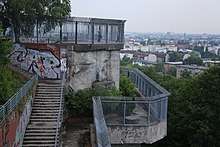
After the war, the demolition of the towers was often considered not feasible and many remain to this day, with some having been converted for alternate use.
Design iterations

Each flak tower complex consisted of:
- a G-Tower (German: Gefechtsturm) "Combat Tower", also known as the Gun Tower, Battery Tower or Large Flak Tower, and
- an L-Tower (German: Leitturm) "Lead Tower" also known as the Fire-control tower, command tower, listening bunker or small flak tower.

- Generation 1
The G-Towers were 70.5 m (231 ft) square and 39 m (128 ft) tall, usually armed with eight (four twin) 12.8 cm FlaK 40 and numerous 37 mm Flak and 32 (eight quadruple) 20mm Flakvierling guns. L-Towers were 50 m × 23 m × 39 m (164 ft × 75 ft × 128 ft), usually armed with four quadruple 20 mm guns.
- Generation 2
G-Towers were 57 m × 57 m × 41.6 m (187 ft × 187 ft × 136 ft), usually armed with eight (four twin) 128 mm guns and sixteen (four quadruple) 20 mm guns. L-Towers were 50 m × 23 m × 44 m (164 ft × 75 ft × 144 ft), usually armed with forty (ten quadruple) 20 mm guns.
- Generation 3
The G-Towers were 43 m × 43 m × 54 m (141 ft × 141 ft × 177 ft), usually armed with eight (four twin) 128 mm guns and thirty-two (eight quadruple) 20 mm guns.
The evaluation of even larger Battery Towers was commissioned by Adolf Hitler. These would have been three times the size and firepower of flak towers.
Towers
Flakturm I – Berliner Zoo, Berlin
The tower built near the Berlin Zoo was the first generation type and covered the government district. It was also used as a repository from artefacts from the Berlin museum. The occupants surrendered to Soviets on 30 April 1945 In 1947 the British blew up the G-Tower on the second attempt with several tons of explosives. 52.509886°N 13.335862°E. The L-Tower was demolished first in July. 52.511722°N 13.339678°E
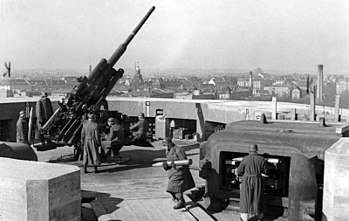 Heavy flak position on the Zoo Tower
Heavy flak position on the Zoo Tower
Flakturm II – Friedrichshain, Berlin
- Friedrichshain (1st Generation)
- G-Tower was partially demolished after the war; one side remains visible. The tower was caught in low-level aerial footage of the ruined city in 1945.[5] 52.526522°N 13.431886°E
- L-Tower was demolished after the war. 52.527884°N 13.438582°E
Both towers were covered over and now appear to be natural hills in Volkspark Friedrichshain. The G-Tower, known as Mont Klamott (Rubble Mountain) in Berlin, was the inspiration for songs by singer-songwriter Wolf Biermann and the rock band Silly.
Flakturm III – Humboldthain, Berlin
The third of the first generation flak towers was built at Humboldthain The G-Tower was partially demolished after the war; one side remains visible. The interior can be visited. 52.547238°N 13.384961°E. The L-Tower was partially demolished after the war; some walls remain visible. 52.544092°N 13.387326°E
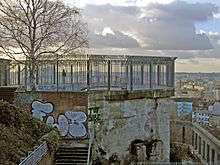
Flakturm IV – Heiligengeistfeld, Hamburg
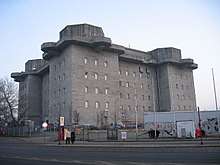
Heiligengeistfeld (1st Generation)53.556212°N 9.970104°E
The G-Tower was transformed into a nightclub with a music school and music shops. In October 2019, the NH Hotel Group announced plans to turn it into a luxury hotel, opening in 2021.[6] This tower, containing six levels below the rooftop, includes in its design, as part of its air-raid shelter, two identical spaces for protection against gas attacks, one on the first floor (above ground level) and the other on the second floor. Both in Tower 1, they are about 300 sq. m. (3,230 sq. ft.) in area, and have six windows (openings in the wall).[7] The L-Tower was demolished after the war and replaced by a building owned by T-Mobile. 53.55285°N 9.967314°E.
Flakturm VI – Wilhelmsburg, Hamburg
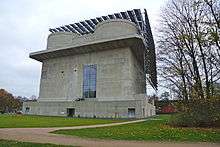
The tower at Wilhelmsburg is a 2nd generation type. The G-Tower remains to this day, 53.51006°N 9.98993°E, the L-Tower was demolished after the war.
Flakturm V – Stiftskaserne, Vienna
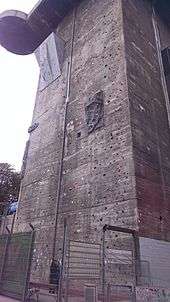
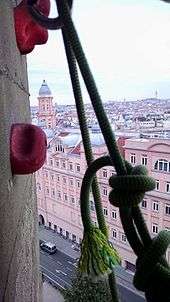
- Stiftskaserne (3rd Generation)
- G-Tower's interior is used by the Austrian Army. 48.201734°N 16.355853°E
- L-Tower (in Esterhazypark) has been used as a public aquarium, the Haus des Meeres, since 1957. 48.197719°N 16.352495°E
- The outside of the L-Tower re-purposed an outdoor climbing wall.[8]
- Flakturm V G-Tower
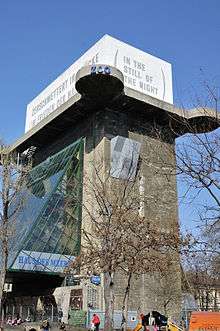 Flakturm V L-Tower
Flakturm V L-Tower- View from the climbing wall
Flakturm VII – Augarten, Vienna
- Augarten (3rd Generation)
- G-Tower remains empty. The entire north-east and half of the east 20 mm gun platforms have been removed during 2007 including the connecting walkways due to deterioration. The tower itself has been reinforced with steel cables encircling the entire structure, 12 cables are located above the gun nests, 6 just below, and an additional 4 midway up the tower. The tower is home to thousands of pigeons which nest on every platform and opening. The tower suffered an internal explosion, and several floors near the top are missing on one side. The west side of the structure is also used as a cellular communications tower. 48.22563°N 16.372815°E
- L-Tower remains empty. Its use as a computer storage facility or an open-air cinema is being considered. 48.227896°N 16.377992°E
- Flakturm VII G-tower
- Flakturm VII L-tower
Flakturm VIII – Arenbergpark, Vienna
- Arenbergpark (2nd Generation) 48.198448°N 16.391489°E
- G-Tower is used as a storehouse for art.
- L-Tower remains empty.
- Flakturm VIII G-tower
- Flakturm VIII L-tower
Planned towers (not built)
Berlin
- Tiergarten (two additional planned, not built)
- Hasenheide in Tempelhof (planned, not built, had been built in Hamburg instead)
- Reichstag (considered for modification, but found unsuitable)
Bremen
- Bremen Neustadt Contrescarpe (two planned, none built)
Hamburg
- East Hamburg (planned, not built)
Munich
- München Hauptbahnhof (eight planned, none built)
Vienna
- Original plans were to place the three towers in Schmelz, Prater & Floridsdorf.
Notes
- Bjorkman, James. "Flak Towers of World War II". FilmInspector.com. Retrieved 18 December 2014.
- George Pagliero (2008). Hitler's Secret Bunkers (Documentary). United Kingdom: Fulcrum TV.
- George Pagliero (2008). Hitler's Secret Bunkers (Documentary). United Kingdom: Fulcrum TV.
- Beevor, Antony (April 2009). Berlin:The Downfall.
- "Flying over the ruins of Berlin in 1945 (in color), Part 2". YouTube. Chronos Media. 1945. Retrieved 17 October 2019.
- "Former Nazi Bunker To Open As Luxury Hotel In Hamburg, Germany". Forbes. 14 October 2019. Retrieved 17 October 2019.
- "Amtbau Pläne des Gefechtsturms IV" in Sakkers, Hans. Flaktürme Berlin – Hamburg – Wien. Fortress Books, 1998, Nieuw-Weerdinge, Netherlands.
- "Flakturm". www.oeav-events.at. Retrieved 10 April 2018.
Further reading
- Foedrowitz, Michael. (1998). The Flak Towers in Berlin, Hamburg and Vienna 1940–1950. Schiffer Publishing. ISBN 0-7643-0398-8
- Ute Bauer Die Wiener Flaktürme im Spiegel Österreichischer Erinnerungskultur, Phoibos Verlag, Wien 2003. ISBN 3-901232-42-7
- Flavia Foradini, Edoardo Conte: I templi incompiuti di Hitler", catalogo della mostra omonima, Milano, Spazio Guicciardini, 17.2–13 March 2009
- Valentin E. Wille: Die Flaktürme in Wien, Berlin und Hamburg. Geschichte, Bedeutung und Neunutzung, VDM-Verlag, Saarbrücken 2008, ISBN 3-8364-6518-3
- Flavia Foradini: Berlino: Cercando sotto terra le tracce dei ciclopici sogni nazisti", Il Piccolo, Triest, 19 agosto 2012.
- Flavia Foradini: I bunker viennesi", Abitare, Milano, 2.2006
External links
| Wikimedia Commons has media related to Flak towers. |